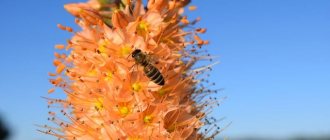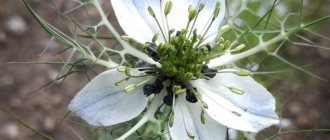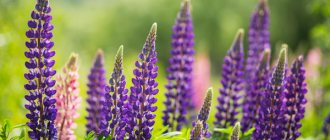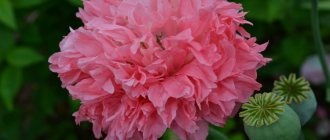From May to July, a low shrub with flowers in shades from yellow to bright orange is found in city parks. This is a representative of the buttercup family - the swimsuit (Trollius). In the European version, the name comes from the legend of forest trolls.
“Trollblumen” translated from German means “troll flower”; according to legend, this is the flower these forest inhabitants prefer to others.
In the Slavic version, the name correlates with the patroness of reservoirs, next to which this flower is often found - Agrafena Bathing Suit.
What does a swimsuit flower look like?
This plant is also called sparkle in everyday life. This is not surprising, since it is distinguished by spherical flowers of fiery shades. The structure of the flower is very interesting: it consists of a perianth, resembling a corolla, and bright sepals, which can number from five to 20. The stamens of different species may differ in length. The nectaries of this plant are modified petals. The honey pit is located at their base. The sweet aroma of the lights attracts bees.
European swimsuit
The fruits of this plant are leaflets that form a spherical fruit. The seeds are oval in shape and have a shiny black surface.
For your information! This perennial herbaceous plant belongs to the Buttercup family. Only it looks less like garden ranunculus and more like more modest marigolds.
Briefly about the history of appearance
In the wild, lights have been distributed throughout Eurasia since ancient times. Their brief history should begin with the fact that they have been grown in gardens for more than 500 years, mainly for decorative purposes (while in the East, lights are considered medicinal plants). Planting and caring for swimsuits did not require much effort, and this contributed to their popularity. But in those days, mainly the European variety was bred; all the others appeared much later.
Note! The Chinese swimsuit flower first appeared in Europe only 200 years after the domestication of local varieties began. But they were used to breed many modern hybrid varieties.
Why is it called troll flower?
The Latin name for this flower is “Trollius”. Many researchers believe that this name comes from "Trollblume", which translates as "troll flower". Indeed, the swimsuit plant develops well in damp places, where, according to legend, these fairy-tale characters like to settle. In many legends, both Scandinavian and German, this plant is the favorite flower of trolls; supposedly, these creatures brew a healing drink in its spherical flowers.
However, there is another version of this name. Perhaps, given the spherical shape of the flower, the name comes from the Latin word “trulleus”, meaning “round vessel”.
Plant characteristics
In the wild, crop species can grow in a variety of conditions, which influences their characteristics. For example, in Eastern Europe, swimmers grow in forests, as well as in river valleys and near ponds, so they prefer high humidity. In Western Europe and partly in Asia, lights grow in the mountains. These species are relatively drought-resistant. Regardless of whether they grow on the edge of a forest or in the mountains, all these species are very resilient and unpretentious.
A wise approach to caring for the trolls’ “favorite”
Although the plant does not require special attention to itself, this does not mean that it does not need to be taken care of. In fact, planting and caring for a swimsuit is considered an enjoyable activity for gardeners. It includes 4 main procedures:
- hydration;
- weeding;
- feeding;
- loosening the soil.
It is important to water the plant in a timely manner so that the swimsuit does not suffer from “thirst”. As soon as the soil has dried out, it is time to give it a new portion of moisture. In dry times, the procedure is repeated almost every day.
You can feed the flower with peat or special fertilizers. It is better to do this in early May and immediately before the buds are released. Gardeners recommend preparing a solution from the following components:
- clean water (10 l);
- urea (1 tablespoon);
- nitrophoska (1 teaspoon).
Feeding is done in small doses at the appointed time.
To rid the plant of its weed neighbors, it should be weeded periodically. As a result, the flower will not lose its decorative appearance throughout the season. If there are no weeds in the flowerbed, you should loosen the soil. This procedure has a beneficial effect on the development of the swimsuit. After some time, the summer cottage will turn into a kingdom of exquisite fiery flowers.
Types of swimsuits and their characteristics
There are many varieties of this plant, which differ even in external characteristics.
Ledebour's swimsuit (Trollius Ledebourii)
Ampelous impatiens - flower, planting and care
This is one of the most interesting species. Ledebur's bathing suit has a rather high peduncle (up to 1 m). Its flowers are large, reaching 6 cm in diameter with bright orange petals. In cultivation, they can be large in size, up to 8 cm. At the same time, the length of nectaries is at least 1.5 cm. In gardening, different varieties are used, which may differ in the coloring of both petals and sepals.
Asian swimmer (Trollius asiaticus)
This species is widespread in landscape design. It is distinguished by bright orange flowers with spread sepals and clearly visible stamens.
For your information! In everyday life, this type is called frying, not swimsuit. There are many varieties of it, including those with double flowers.
Asian swimsuit
In the wild, the height of the peduncle is about 40 cm, but at home it grows more noticeable - up to 70 cm.
European swimsuit (Trollius Europaeus)
This species is also called the common swimsuit. Its description says that its stems can reach 100 cm in height, making it one of the most noticeable varieties. The flowers are large in size and have a pleasant aroma. The color of the petals varies from light yellow to golden. Their stamens are longer than the petals. Blooms in late spring - first half of June.
Note! This plant is becoming increasingly rare in the wild. It is listed in the Red Book of the Republic of Belarus. On the territory of Poland it is also protected by the state.
Trollius Altissimus
The main difference between this species is the height of the peduncle; it is 1.3-1.5 m. Moreover, the plant has quite beautiful openwork leaves. But the flowers of the highest swimsuit are not too bright. They reach a diameter of 6 cm, but are distinguished by a pale greenish-yellow hue.
Dwarf swimsuit (Trollius Pumilus)
As the name suggests, this species is distinguished by its modest size. The rosette of the plant is formed by carved leaves with a jagged edge. From there, around mid-May, straight flower stalks grow, reaching a height of 15-30 cm. But at the same time, their flowers are quite large, at least 2-3 cm in diameter. They are distinguished by the beautiful golden hue of their sepals.
Altai swimsuit (Trollius Altaicus)
This is a fairly tall variety. Its stem grows up to 90 cm in height. Distinguished by slightly open flowers. The sepals have a red tint on the outside. Inside the flower, black pistils and dark red or purple anthers are visible. Flowers appear at the end of May and delight the eye for the whole month.
Cultural swimsuit (Trollius Cultorum)
It differs from other species in that it is a hybrid. Its botanical “ancestors” are plants of four species. These are the Asian, European, Altai and large-petal swimsuits described above. As a result, the leaves of the resulting garden bathing suit have a brighter, juicy green hue. Peduncles grow up to 60-90 cm in height. The flowers are large, their diameter on average is 7 cm.
Important! The color of this hybrid species can be different, including cream, pale yellowish, and orange-red. There are many varieties of it with double flowers.
A special feature of this plant is also that its varieties differ in their flowering time; you can even find those that will bloom until mid-July.
Paper sepal swimsuit (Trollius Chartosepalus)
This species is found in the wild in the northern regions. It is listed in the Red Book. This is a miniature plant, its height is only 15 cm. Its flowers are pale, most often cream-colored. Diameter is about 3 cm.
Half-open swimsuit (Troilius Patulus)
A special feature of this species is its low and practically non-branching stems. They rarely grow to a height of more than 35 cm. Its flowers are medium-sized, up to 30 cm in diameter, and have a golden hue. After flowering ends, the plant stem increases in length.
Lilac swimsuit (Trollius Lilacinus)
While most varieties have yellow or orange flowers, less often cream, this species has a very unusual purple color. But its nectaries are greenish-yellow, like those of other “relatives” growing in the Far East. And in all other respects it looks almost like the Asian variety. Except that the flowers are smaller, maximum 5 cm in diameter.
Lilac swimsuit
Large-petaled swimsuit (Trollius Macropetalus)
This variety has powerful peduncles that can reach a height of 100 cm. But the diameter of the flower is up to 5 cm. The usual colors are yellow and orange. The leaves of this species are large, up to 15 cm wide.
Description
Garden bathhouse (kupavnitsa, balabolka, trollius, troll flower) is a herbaceous plant reaching a height of 1 m. It belongs to the Ranunculaceae family. In the wild it is found in Asia, North America, and Europe on moist soils, which is why it got its name.
The culture has lobed carved leaves. It blooms starting from the second year of life. The buds are yellow, large, spherical. The perianth resembles a corolla with 5-20 sepals. Inflorescences appear in May-June, emitting a fresh aroma.
Kupava flower is a poisonous plant. Any manipulations with it in the garden are carried out with gloves. In folk medicine, it is used to prepare decoctions for edema and tumors.
Varieties most popular among gardeners
Erythronium pagoda - description of the plant
The most common varieties at the moment are:
- Goliath. This variety is distinguished by very large flowers, reaching a diameter of 7 cm. They attract attention not only in size, but also in the beautiful light orange hue of the nectaries;
- Orange King. Dark orange sepals are the main characteristic of this variety. At the same time, the plant is of medium size;
- Lemon Queen. In full accordance with its name, this variety has lemon-yellow flowers;
- Lightball. The stems of this variety reach a height of 60 cm. The flowers have a beautiful light orange hue;
- Orange Princess. This swimsuit is orange with wide-open flowers and tall stamens;
- Fire Globe. The variety is distinguished by orange nectaries and orange-red sepals, but otherwise looks very similar to Orange Princess;
Lemon queen swimsuit
- Orange Globe. The flowers of this variety are large, bright orange, and the sepals are compact;
- Canary Bird is a variety of yellow cultivar, that is, a hybrid variety with light flowers;
- Alabaster. Another hybrid variety, only this time a variety of the cultivated white swimsuit. It is distinguished by relatively low bushes up to 60 cm in height;
- Elist of All. This is an early variety with bright yellow flowers reaching 7 cm in diameter. But the flower stalks themselves are relatively low, up to 50 cm;
- Goal Cross. This variety looks very unusual: its sepals are yellow and the nectaries are orange, so it looks beautiful, despite the fact that the flowers themselves are quite small;
- Goldquel. A beautiful variety with spectacular and large bright yellow flowers, the diameter of which can reach 6 cm.
Propagation by seeds
Mock orange snowbel - description, planting and care
To propagate almost all types of swimsuit, it is better to use seeds, although cuttings are theoretically possible, but this is considered a more complicated method.
Important! This plant does not have to be grown from seedlings. It can be sown in open ground. But to ensure high germination, seeds need long-term stratification.
Seed material is collected in July-August, depending on the flowering time of a particular variety.
Boarding time
Most often, seeds are sown in the ground after stratification; this occurs already at the end of October or November.
Mandatory seed stratification
Experienced gardeners mix the seeds collected in August or July with slightly moistened sand, transfer this mixture into a bag and store it in the refrigerator in a box intended for vegetables at a temperature of 2-4 ° C. The seeds must remain there for three months to achieve the desired parameters.
Soil preparation
You need to grow the swimsuit in loose soil with good breathability. Therefore, most often they make a mixture of two parts peat, the same amount of earth and one part sand.
Picking
Shoots begin to appear in the first half of May. If the weather gets hot, they will develop actively, especially if they are provided with abundant watering and protection from the sun. They should be picked after a pair of full leaves appear on the seedlings. The sprouts are planted at a distance of 7-10 cm from each other. As a rule, a year after this, the already strong and expanded plants are planted in a permanent place in the garden.
Is it possible to replant from a pot?
As a rule, this perennial is immediately planted in open ground. But many gardeners plant it in a container for the first year. Then in the second year the question arises of how to plant a bathing suit from a pot. In this case, you need to act carefully so as not to damage the roots.
Important! It is best to carry out the procedure after flowering, when the lights begin their dormant period. This happens in August.
Secrets of growing troll flower at home
In order for a wonderful piece of sun to appear on your site, you can use traditional options: dividing the bush, buying seedlings in the store and sowing the bathing suit with seeds. The latter method is used for growing plants, both in open ground and in containers.
Since flower seeds have uneven germination, it is better to first grow seedlings indoors. When it gets stronger, move it to open ground.
Growing the exotic troll flower from the seeds of the bathing suit begins with preparing the soil. It must meet the following requirements:
- looseness;
- breathability;
- nutritional value.
It is obtained by mixing peat, leaf soil and humus in equal parts. To know how to grow a swimsuit from seeds, you should familiarize yourself with the basic rules of this process.
Sowing begins in the winter, preferably in January, in order to prepare the seedlings in a timely manner. First, the prepared soil is placed in containers, after which shallow holes are made at a distance of 35-40 cm. Next, the containers are placed in a room where the temperature does not exceed +4 ° C for 3 months.
Growing a swimsuit and caring for the plant involves regular watering. It is carried out as the top layer of soil dries quickly. When sprouts appear, a dive is carried out, leaving the best specimens. At the end of summer, young flowers are planted in open ground in a suitable area of the garden.
If it is not possible to grow seedlings, swimsuit seeds can be sown directly in open ground in the fall.
Features of garden care
Growing a swimsuit flower is not particularly difficult even for a novice gardener.
What conditions does the swimsuit like?
Much depends on the climate zone in which this perennial is grown. But in most of Russia, lights prefer weak shading. In open areas, unless the soil is too dry, this perennial does well.
What is the plant afraid of?
During the growth period, the plant is afraid of a lack of moisture, so you need to provide the troll flower with regular watering. In addition, the fire does not like to be transplanted; bushes can grow in one place for at least 10 years. He also has a bad attitude towards digging up the earth around the bush, since the root system grows quickly. These perennials produce a lot of extra stones, and digging can damage them.
Watering
To grow a healthy and beautifully flowering plant, the flame needs to be watered regularly between March and July so that the soil is moist. From August to September, the frequency and intensity of watering is reduced.
Mulching
This technique is optional when growing lights. But it saves the garden owner from weeding at least this area, and also protects the soil from drying out, so you shouldn’t give it up.
Important! The rules are the same as for other plants. Humus or a mixture of sand and peat is added to the bush.
Loosening
The weak point of this plant is that it does not like stagnant groundwater, which is why it requires regular loosening and good drainage of the soil.
Feeding
All varieties of European swimsuit develop well, without requiring special care. However, in order to improve the troll flower’s resistance to adverse environmental factors, experts advise treating it with ash. This is done in early spring. Then, at the beginning of active growth, fertilizing with nitrogen fertilizers will be required. And only then complex fertilizers are used for better flowering.
Transfer
This perennial does not like transplants, and unless absolutely necessary, you should not disturb it. But if the bushes grow too quickly, they are divided into several parts and replanted.
Growing in the garden
In order for the swimsuit to grow well and delight the eye with lush flowering, it requires regular watering, weeding and loosening of the soil. When loosening, you cannot go deeper than 3-5 cm, so as not to touch the surface roots. The soil around the bushes should be constantly mulched with peat or humus. You need to periodically add nutrient mixtures to the base of the bushes.
In the first year of life, the swimsuit has only one peduncle. Over time, their number increases. The apical flower blooms first; buds only appear on the lateral shoots during this period. To obtain secondary flowering, the bush must be cleared of faded flower stalks.
The swimsuit can grow in one place for up to 10 years, constantly growing. Periodically, the bush needs to be divided and replanted.
Choosing a location
Plants do best in sunny areas. With proper care, they can reach a height of 50-60 cm. But young bushes immediately after transplantation need protection from direct rays of the sun.
In shady places, the plant can grow up to 80-90 cm. However, it does not bloom as profusely as in open areas, and has flowers of a dull color. A bush growing in the shade develops slowly and reaches its maximum height only in the 6th year.
Watering and fertilizing
The plant requires constant and abundant watering. Especially during the hot summer period. Irrigation requires settled warm water. For this purpose, experienced flower growers place a large container of water in an open place so that it is heated by the sun. After watering, the soil around the plant must be loosened.
Fertilizing is carried out periodically along with watering. For this, urea, agricole or nitrophoska are used. The solution is prepared at the rate of 1 tsp. substances for every 10 liters of water. The best time to apply fertilizer is during bud break and the beginning of flowering.
Reproduction and transplantation
The swimsuit can be propagated by seeds. They are sown in mid-autumn. Only in May next year will shoots appear. They can be transplanted to a permanent place in the spring of the second year. The seeds of the plant are small and quickly lose their viability. They need to be sown immediately after harvest.
The swimsuit is capable of actively reproducing by self-sowing. Seedlings sprout in the spring, but they can only be replanted in early autumn. They will begin to bloom in the second year, but lush flowering will begin only in the third.
The most popular method of propagation is by dividing the clump. The process is carried out every 5 years in late summer - early autumn. Healthy, strong bushes that are at least 5-6 years old are selected for planting. By this age, the plant strengthens and gains vitality, and is able to more easily withstand the stress associated with transplantation.
The donor bush is dug up, the roots are cleared of soil and washed. Then, using a sharp knife, the bush is cut into pieces so that rosette stems with roots remain on each. The cut areas are treated with a weak solution of potassium permanganate or wood ash.
Holes for plants are prepared in advance. The distance between them should be 30-40 cm. The root collar should be deepened by 20-30 cm, having previously removed the root foliage. Young leaves grow back after 14-16 days.
Wintering
The swimsuit tolerates frost well, so it does not need additional insulation. In mid-autumn the leaves die. They are cut off, but they do it so that a small petiole remains above the surface. It will protect the bud located in the middle of the outlet. It is from this that a new flower stalk will grow in the spring.
Diseases and pests
The swimsuit is resistant to diseases and various types of pests. But improper care can cause fungal infection. As soon as the first signs of disease appear on the plant, the affected parts must be removed immediately. If the damage is significant, the bush is dug up entirely and destroyed. The soil surface and nearby plants are treated with a fungicidal solution.
When and how does it bloom
Whether it is white, yellow or orange, this plant blooms very beautifully. However, most varieties have a slight sweetish aroma.
Types of flowers
In cultivation there are varieties with regular or double flowers, consisting of five or 9-10 petals.
Alabaster swimsuit
Flower shapes
The perennial bathing grass has only one flower shape - spherical. But the flowers can be half-open or open.
Flowering period
When the garden bathhouse blooms, it depends on the specific variety. Most of them open flowers in the second half of May. In general, the flowering period lasts 3-4 weeks. Some varieties are pleasing to the eye until the end of July.
Changes in care during the flowering period
This plant is distinguished by its unpretentiousness; when the swimsuit blooms, it does not require special care, with the exception of one nuance.
Important! Experienced gardeners recommend spraying the plant with epin at the very beginning of this period. It is a universal adaptogen.
Landing method
Before planting seedlings in the ground, holes are made in the ground at a distance of 0.4-0.5 m. You can put several granules of nitroammophoska inside. Seedlings are planted in a prepared hole with a lump of earth, deepening the root collar by 2 cm. Sprinkle earth on top.
After planting, the leaves must be trimmed for better rooting. Within 2 weeks new foliage will appear. Subsequently, it is undesirable to touch the plants: trollius does not like transplants and can successfully bloom in one place for up to 10 years.
Possible problems in growing
Swampweed is a marsh grass. It does not grow in the most favorable conditions, so it is highly resilient and does not require special care.
Pests
This plant is toxic to insects, so it is not susceptible to pest attacks.
Diseases
The swimsuit has increased immunity to most diseases. However, the troll flower may be threatened by a fungus. To prevent infection, it is enough to pick off dried leaves in time and follow the watering regime.
However, there is always a risk of contracting fungus in the garden. Therefore, if this does happen, you must definitely destroy the infected parts of the plant and treat it with a fungicide.
Signs of improper care
Premature yellowing of the leaves may indicate that the plant needs shading because it receives excess sunlight.
How to grow a plant: step-by-step instructions
You can sow seeds directly into open ground. To do this, at the end of October - beginning of November, you should dig up the area and make grooves with a depth of 0.5 mm. The seeds must be mixed with river sand, evenly distributed over the surface of the depressions and sprinkled with soil. Sprouts will appear in early May.
This method does not provide a 100% guarantee that the flowers will sprout. So it is preferable to grow the swimsuit in seedlings.
Growing seedlings
You need to start growing seedlings at the end of October.
Seedling boxes should be filled with a mixture prepared from the following components:
- leaf soil;
- humus.
To prevent future plants from suffering from diseases and pests living in the leaf soil, it must be disinfected. To do this, you need to evenly distribute it over the surface of the heat-resistant form; the layer should not exceed 5 cm.
The soil will need to be filled with hot water and placed in an oven preheated to 90°C. The substrate will need to be disinfected for 30 minutes. Then you need to remove it from the oven, cool it to room temperature and only then mix it with humus.
The seeds must be distributed over the surface of the soil and pressed lightly. The boxes must be moved to an unheated basement or garage. There the seeds will undergo natural stratification, which will increase their germination.
At the end of February you need to move the containers indoors. The containers should be installed in a well-lit place, but without direct sunlight, and covered with plastic film or glass.
In order for the seeds to germinate, you will need to regularly spray the planting with warm water from a spray bottle and maintain a temperature of +18...+20 °C near the containers. It is also necessary to periodically ventilate the greenhouse and remove condensation from the shelter.
The first shoots will appear after 30 days. When this happens, you need to gradually accustom them to normal conditions. To do this, it is necessary to remove the shelter from landing for an hour at first, gradually increasing the duration of such sessions. You should also regularly spray the soil with warm water from a spray bottle, keeping it moist.
When the seedlings have 2 true leaves, you need to plant the seedlings in individual containers. Plastic cups will work, but they should have drainage holes. And they need to be filled with a mixture of peat and sand. 10-14 days after picking, the seedlings need to be fed with nitrogen fertilizer in a minimum concentration.
The photo describes the features of the swimsuit flower.
Plants should be planted at the end of summer. But before planting, you should prepare the area for the flower bed. To do this, you need to dig up the soil and add sand, wood ash, peat and humus as necessary. Plants can be planted on the site only 14 days after preparation.
The procedure itself must be carried out according to the following algorithm:
- For plants, you need to dig holes with a depth of 18-20 cm. You will need to maintain a distance of 50 cm between the holes. The holes should be watered generously.
- The seedlings need to be well moistened and removed from the containers along with the earthen lump. Plants need to be installed in the center of the recesses.
- The voids must be filled with prepared soil. It is important that the root collar of each plant is 2 cm below ground level.
Swimsuits grown from seeds will bloom only after 2-3 years.
Use in landscape design
This perennial plant is widely used in landscape design. It is mainly planted when creating rock gardens, as well as rockeries, that is, rocky gardens.
Important! Considering the ability of the swimsuit to grow in areas with high humidity, this flower can be grown on the banks of artificial reservoirs.
This plant combines beautifully in rock gardens with edelweiss and chickweed. But for this purpose miniature varieties are selected. For example, a dwarf swimsuit is suitable. Since after flowering the plant loses its decorative effect, and only in the fall the basal rosette grows on the swimsuit, it needs lush neighbors like Siberian irises and daylilies. Among the shrubs, it gets along well with holly mahonia and Japanese spirea.
Chinese swimsuit
Thus, this is a universal flower that is unpretentious in care, is not afraid of parasites, and rarely catches an infection. It is easy and simple to grow. And its flowering is unforgettable.
Reproduction
In nature, the swimsuit reproduces by seeds. The leaflet fruits ripen approximately a month after flowering. The seeds are small, dark, with shiny skin. In the first year after sowing, the plant just begins to form; most often there are no flowers.
You can propagate a swimsuit in a similar way at home, but it will require a lot of effort. Seeds should be stratified in winter for 2-3 months in moist soil, planted in early spring in a greenhouse, and shoots monitored. Flowering of such plants usually occurs in 3-4 years.
Cultivated plants are often propagated vegetatively—by parts of rhizomes or cuttings. This should be done in early spring or autumn.
When propagating by parts of the rhizome, a healthy, washed root is divided into several parts so that a shoot remains on each. The sections are treated with a manganese solution and planted.
Propagation by cuttings should be carried out in the spring, before flowering begins. Ground shoots are cut and placed in water. Once the plant has taken root, it can be planted. Planting shoots of the swimsuit should be done at a distance of at least 50 cm from each other, future bushes will grow.











